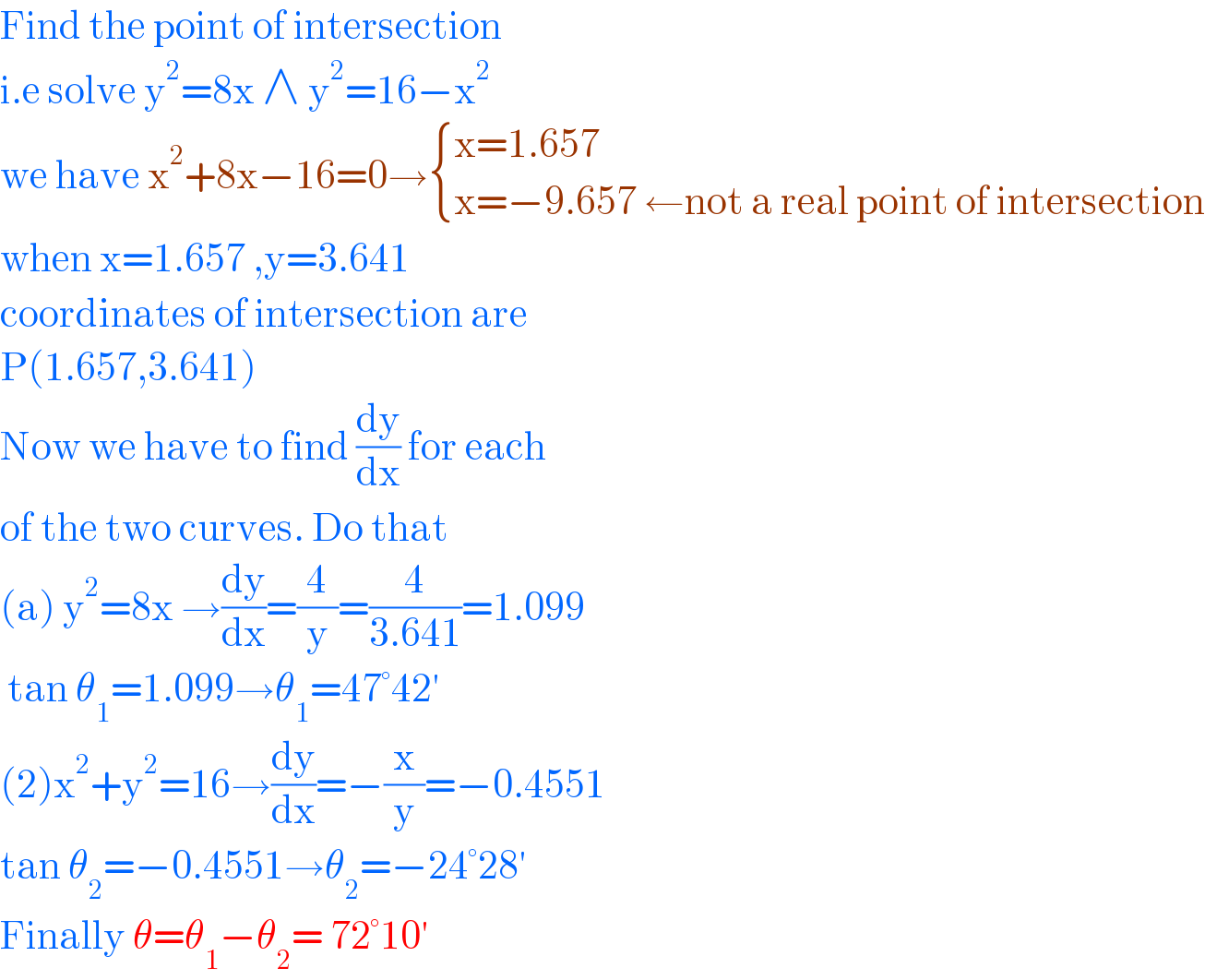Question Number 130294 by bramlexs22 last updated on 24/Jan/21

$$\mathrm{Find}\:\mathrm{the}\:\mathrm{angle}\:\mathrm{between}\:\mathrm{y}^{\mathrm{2}} =\mathrm{8x}\: \\ $$$$\mathrm{and}\:\mathrm{x}^{\mathrm{2}} +\mathrm{y}^{\mathrm{2}} =\mathrm{16}\:\mathrm{at}\:\mathrm{their}\:\mathrm{point}\:\mathrm{of} \\ $$$$\mathrm{intersection}\:\mathrm{for}\:\mathrm{which}\:\mathrm{y}\:\mathrm{is}\:\mathrm{positive} \\ $$
Answered by benjo_mathlover last updated on 24/Jan/21

$$\mathrm{Find}\:\mathrm{the}\:\mathrm{point}\:\mathrm{of}\:\mathrm{intersection} \\ $$$$\mathrm{i}.\mathrm{e}\:\mathrm{solve}\:\mathrm{y}^{\mathrm{2}} =\mathrm{8x}\:\wedge\:\mathrm{y}^{\mathrm{2}} =\mathrm{16}−\mathrm{x}^{\mathrm{2}} \\ $$$$\mathrm{we}\:\mathrm{have}\:\mathrm{x}^{\mathrm{2}} +\mathrm{8x}−\mathrm{16}=\mathrm{0}\rightarrow\begin{cases}{\mathrm{x}=\mathrm{1}.\mathrm{657}}\\{\mathrm{x}=−\mathrm{9}.\mathrm{657}\:\leftarrow\mathrm{not}\:\mathrm{a}\:\mathrm{real}\:\mathrm{point}\:\mathrm{of}\:\mathrm{intersection}}\end{cases} \\ $$$$\mathrm{when}\:\mathrm{x}=\mathrm{1}.\mathrm{657}\:,\mathrm{y}=\mathrm{3}.\mathrm{641} \\ $$$$\mathrm{coordinates}\:\mathrm{of}\:\mathrm{intersection}\:\mathrm{are} \\ $$$$\mathrm{P}\left(\mathrm{1}.\mathrm{657},\mathrm{3}.\mathrm{641}\right) \\ $$$$\mathrm{Now}\:\mathrm{we}\:\mathrm{have}\:\mathrm{to}\:\mathrm{find}\:\frac{\mathrm{dy}}{\mathrm{dx}}\:\mathrm{for}\:\mathrm{each}\: \\ $$$$\mathrm{of}\:\mathrm{the}\:\mathrm{two}\:\mathrm{curves}.\:\mathrm{Do}\:\mathrm{that}\: \\ $$$$\left(\mathrm{a}\right)\:\mathrm{y}^{\mathrm{2}} =\mathrm{8x}\:\rightarrow\frac{\mathrm{dy}}{\mathrm{dx}}=\frac{\mathrm{4}}{\mathrm{y}}=\frac{\mathrm{4}}{\mathrm{3}.\mathrm{641}}=\mathrm{1}.\mathrm{099} \\ $$$$\:\mathrm{tan}\:\theta_{\mathrm{1}} =\mathrm{1}.\mathrm{099}\rightarrow\theta_{\mathrm{1}} =\mathrm{47}°\mathrm{42}' \\ $$$$\left(\mathrm{2}\right)\mathrm{x}^{\mathrm{2}} +\mathrm{y}^{\mathrm{2}} =\mathrm{16}\rightarrow\frac{\mathrm{dy}}{\mathrm{dx}}=−\frac{\mathrm{x}}{\mathrm{y}}=−\mathrm{0}.\mathrm{4551} \\ $$$$\mathrm{tan}\:\theta_{\mathrm{2}} =−\mathrm{0}.\mathrm{4551}\rightarrow\theta_{\mathrm{2}} =−\mathrm{24}°\mathrm{28}' \\ $$$$\mathrm{Finally}\:\theta=\theta_{\mathrm{1}} −\theta_{\mathrm{2}} =\:\mathrm{72}°\mathrm{10}'\: \\ $$
